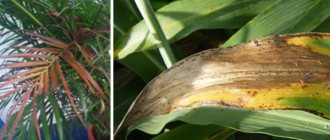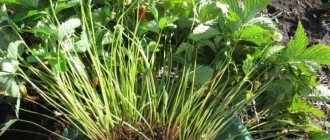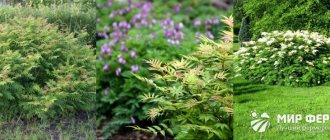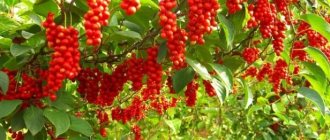- May 13, 2019
- Fruits
- Anisimova Svetlana
Not everyone knows how pineapple grows. Some believe that it grows on a palm tree, but in fact it grows on the ground. It is a herbaceous plant, and although it grows in hot and dry climates, its leaves can grow up to two meters long. It came to Europe from Brazil. But in addition to South America, its range is in the equatorial zone of Central America, Asia, as well as Australia and Africa. It is possible to grow pineapples in greenhouses, as well as as a houseplant that produces lush greenery.
Description of pineapple
Belongs to the bromeliad family, pineapple species. You can see in the photo how pineapples grow in nature. It has different names - crested, large-tufted or real pineapple. This is a perennial herbaceous plant. Reaches a height of 60 cm.
- Leaves. Long, narrow, rough with juicy flesh and jagged edges. They are assembled into a socket.
- Flowers. They are located at the top of the stem emerging from the rosette. There are many of them, and they are arranged spirally and densely, forming an inflorescence called a spadix. Flowers grow together during the growth and development of the fruit. A pair of leaves remain on top of the stem, from which a tuft is formed.
- Fetus. When mature, it is an infructescence reaching a weight of 2 kg and similar to a coniferous cone, having a golden-brown hue with a large green tuft. The peduncle stem grows through the infructescence. Around it there is a delicious sweetish-sour juicy pulp, which is covered with a thick and rough peel formed by the woody parts of the flower and the covering leaf. The unripe fruit is very pungent. It burns the lips, larynx and the walls of the stomach and intestines. This is a strong laxative. The ripe fruit loses its pungency and becomes sweet and juicy.
- Seeds. They are not formed in cultivated varieties. In their natural form they are found in the nests of the fruit in the form of ovules.
How to grow pineapple at home
At home, it can be grown by rooting the top of the fruit.
1. For planting, you should choose a ripe fruit with a golden-brown skin and well-developed strong leaves at the top.
Pineapple plantation
2. Using a sharp knife, cut off the top, then carefully remove all the pulp at the cut site; you can also remove several lower leaves. After which the top is left for a couple of days so that the cut area dries out.
3. Place the top in a container of water and place it on a windowsill or other well-lit place, away from drafts and direct sunlight. Make sure that the entire lower part of the top cut is covered with water.
Periodically, as the water evaporates, add it to the required level.
After about 3-4 weeks, roots will appear at the cut site, and when they grow to 2 cm, the top can be transplanted into soil consisting of peat and sand.
Pineapple, thanks to its amazing taste and attractive appearance, is popular all over the world. Monuments are erected to him, poems are written and entire festivals are dedicated to him. For example, in China and Germany, pineapple is always present on the New Year's table, and in Thailand, every year for several decades on June 2, a carnival dedicated to this exotic fruit has been held.
Where do pineapples grow?
The Mato Grosse plateau, located between Paraguay and Brazil, is considered the birthplace of these delicious fruits. It was from this place that three hundred years ago the plant began to spread throughout warm tropical territories. Breeders have developed many varieties with different flavor nuances. In which countries do pineapples grow? Sweet fruit plantations are located in India, Thailand, USA, China, Vietnam, Mexico, Zaire, the Philippines, Taiwan, and the Azores.
But that's not all. Pineapples can be grown in greenhouses in any area with sufficient sunny days. It is well known that in the 18th-19th centuries they were grown and the fruits were obtained in the greenhouses of some noble estates in Russia. But the most delicious and juicy fruits come from plantations where pineapples grow. The countries where the main supplies come from are located in the Hawaiian Islands, the Philippines, as well as Costa Rica and Brazil. They are grown using a specially developed technology and have large fruits.
Origin of pineapples
For the first time, Brazilians had a chance to try pineapples. A few years later, following the discovery of the American continent, the exotic fruit spread to Africa, Southeast Asia and the Indian Peninsula.
Pineapples in nature
The fruits of this amazing plant are well adapted for growing in hot and dry climates. How do pineapples grow in nature, where rain is very rare? The plant is fully adapted to collecting moisture and creating reserves for dry times. The main role in this is played by the long and narrow leaves, which are concave inward, which helps rainwater and dew droplets roll down to the roots.
Water accumulates in the juicy pulp of the leaves. The thick and rough skin protects it from evaporation from the plant. The fruits of pineapple growing in natural conditions are small, weighing up to a kilogram. They are more than two times smaller than those that grow on plantations.
Care
Plant nutrition
Feeding such exotic plants is absolutely necessary. In the summer months it should be done weekly, and the rest of the time - 2 times a month. It is necessary to carefully alternate complexes of mineral and organic fertilizers. Among the latter, solutions of cattle manure have proven themselves to be the best. Once every 2-3 weeks, it is recommended to spray and water the pineapple with an acidified solution of iron sulfate at the rate of 1 gram per 1 liter of water.
Watering frequency
Watering for pineapple is not necessary, but abundant. Do not allow the earthen clod to dry out or have an excess of moisture. The water temperature should not be lower than the air temperature. Spraying is recommended between waterings.
Does it need to be trimmed?
Pineapple is pruned if the leaves dry out or interfere with growth. However, you should not get carried away with pruning, since the number and length of leaves affect the size of the future fruit.
What to do during the flowering period
Even if favorable conditions have been created for the pineapple, it will require stimulation with ethylene to ensure flowering and fruit set. To do this, mix a liter of water with two teaspoons of calcium carbide and leave the resulting solution for about a day. Strain the resulting liquid and pour it into the central part of the leaf rosette every day for a week.
Inflorescence length - 7–15 centimeters
An alternative to the above method is fumigation. For this manipulation, a plastic bag is placed on the tub with the plant, and smoking coals are placed.
Video: how to grow pineapple at home
We hope that the article was truly useful and, despite the peculiarities of care, many gardeners will dare to plant pineapple on their site. Remember that planting and growing exotic fruits is an interesting and exciting task for the whole family.
- Author: Maria Usataya
Rate this article:
- 5
- 4
- 3
- 2
- 1
(2 votes, average: 3 out of 5)
Share with your friends!
How pineapples are grown on plantations
For this purpose, special varieties have been bred whose ripening period is much shorter than that of ordinary pineapples. How does the plant grow on plantations, since the timing of their natural ripening is not entirely acceptable for mass production of pineapples? To speed up the fruiting process, special technologies are used. Already rooted plants, obtained by sprouting green tops, with a height of at least 0.2 meters are planted in the ridges.
The distance between them is 2 meters. To make buds form faster, the plant is treated with acetylene gas. Another trick for getting large fruits with sufficient juiciness is to prevent the flowers from pollinating. To do this, they are covered with plastic bags that prevent access to insects and birds. On huge plantations, automatic watering and processing are used. All this allows you to harvest up to three harvests per year.
How long does it take and how does a pineapple grow?
Once in the ground, the pineapple seed germinates, and it takes 12 to 15 months before it blooms. All this time, a leaf rosette is being formed. Only after a year does the formation of lilac or purple flowers occur. After flowering, small berries appear, which grow together over a short period of time, forming a single fruit.
It takes up to 6 months to mature. Since the plant is a perennial, its fruits can be obtained several times. Now we know how pineapple grows. To reduce the ripening period of the fruit, sprouted green “tufts” are used. This allows you to halve the period of growth and fruiting.
How and on what do pineapples grow?
The large-tufted pineapple belongs to the Bromiliaceae family. The plant grows as a shrub with large sharp leaves, the height of which rarely exceeds 90 cm. In the middle there is a long stem with a peduncle. After several dozen flowers have been pollinated, they will produce small berries. When filled with juice, such berries close together, resulting in a common fruit. That is why the pineapple itself looks like a large cone made up of several dozen small ones.
We have found out what pineapples grow on in nature, now we will find out how these plants reproduce. This happens in several ways:
- seeds, which are located immediately under the peel and look like apple seeds;
- side shoots, which experts rush to cut off as soon as their roots begin to grow;
- the tops of the plant, the so-called “palm”, which should be planted in the ground, in a deep hole.
I wonder how homemade pineapple grows and is it possible? If the temperature conditions allow, then you can get the fruits by planting a seed or purchased top of a plant, after tying a bag around the top of the pot. Cellophane will create a vacuum effect, and comfortable thermal conditions will help the pineapple grow quickly, producing a harvest.
Growing in greenhouses
Pineapple is a heat-loving plant. Although it can remain without water for quite a long time, it will not be able to grow without sunlight. Therefore, it is necessary that the greenhouse premises be warm and with diffused light. This method of growing pineapples is widely used in European countries and southern Russia. The growing technology here is slightly different.
Instead of natural soil, a soil mixture is used, irrigated with slightly acidified water. This leads to rapid growth of the plant. There is a special condition here. Watering should not be done with cold water. It must be at ambient temperature. Under no circumstances should the plant be flooded and the water allowed to stagnate.
Growing Pineapple Indoors
It will be surprising, but it is possible to grow a tropical fruit in an apartment or house. True, the fruit will be small and will not have the rich taste of pineapple. But those who want to try need to buy ripe fruit. It should have a yellow color and be a little soft. There are two ways to plant a plant:
- Carefully cut out the stem of the pineapple along with the green top, pour water into a jar, place it there and place it in a bright place. Keep it there until small roots grow. After this, plant in a large pot, but no more than 4 liters.
- Trim the top of the pineapple. Treat the cut in a weak solution of potassium permanganate. Dry and plant in a pot, watering periodically to form roots. An important condition will be the room temperature. It should be from 25 to 28 degrees.
In order for the pineapple to be comfortable and grow well, several conditions will need to be met. The soil in the pot should be for indoor plants, the place where the container with the shoot is located should be sunny, the water for irrigation should be warm and settled. Regular feeding with a complex of fertilizers selected specifically for bromeliads is necessary.
Transplantation into the ground
When the roots have reached two centimeters, the plant is transplanted into specially prepared soil. A mixture of soil, peat and sand in a ratio of 1:1:1, or ready-made soil from the store, is suitable for this.
Use a medium sized pot for planting at first. Determine the place where it will be located, since pineapple grows actively in bright places, but does not like direct sunlight. To avoid moisture stagnation, excellent drainage is necessary. Watering is carried out no more than twice every seven days.
- Operation of a piston compressor
- Garden equipment from - features and benefits
Plant nutrition
As soon as you notice new leaves, the plant has taken root. But this will happen in eight weeks, not earlier. Otherwise, you should try again, but with a different pineapple.
Now you know how and on what pineapples grow, so you can safely get down to business. And your attempt will undoubtedly be successful, and you will be able to treat your friends and loved ones with pineapple grown at home with your own hands. Good luck!
Time to get fruit at home
This is a long process. You need to be patient and follow all recommendations. It takes a month to a month and a half for the plant to take root. The growing leaves will indicate this. After this, at least six months must pass. During this time, the plant will take root, the leaves will grow and form a rosette from which a stem will grow. Flowers will appear on it. After the cob has flowered, in their place, small fruits are formed, which gradually grow together and form a pineapple.
To speed up the growth process, you can use a solution of calcium carbide, which is prepared at the rate of 1 teaspoon per 0.5 liters of water. Infuses for 24 hours. This method will significantly speed up the growth of the plant and in 12-15 months you will have a fruit grown in your own home. Well, now we know where pineapples grow. They definitely don’t grow on trees, although they look like cones.
From the history of pineapple
Pineapples are the second most consumed fruit in the world. The most popular pineapple variety, Del Monte Gold, was bred in 1970 at a research institute in Hawaii. And the largest pineapple fruit was grown in Australia in 2011. His weight was more than 8 kg.
Pineapple has another name - pineapple (English) or pine apple. The origin of the name is explained by the fact that the fruit is similar to a pine cone, due to the hard scales that cover the entire surface of the fruit and maintain its juiciness.
In Mexico, pineapple peels are used to produce tepache, an alcoholic drink similar to home brew. And in the Philippines, textile fiber is extracted from pineapple leaves, used to produce thin ivory-colored fabrics, from which underwear, handkerchiefs, children's and women's shirts are sewn. Pineapple fiber is also used to make paper, twine and rope.
A few facts about pineapple:
- Pineapple is native to the tropics of South America, more specifically Paraguay and southern Brazil, where it was cultivated and then distributed all the way to Mexico.
- Christopher Columbus is considered to be the first European to taste pineapple. This is exactly the gift that the inhabitants of the island of Guadeloupe gave him when he and his crew landed on the American shore in 1493.
- At the beginning of the 16th century, the Portuguese first planted pineapple on the island of St. Helena. And later it was brought to India and Africa.
- For the first time in Europe, pineapple was grown at the end of the 17th century in the greenhouse of the Duke of Cleveland. It was presented to the King of England as a gift.
- Thanks to greenhouses, in the 18th - 19th centuries, pineapples were successfully grown in France, Holland, Germany, Great Britain, the European part of Russia and even Siberia.
Over the past 60 years, pineapple cultivation worldwide has increased 5-fold. And the volume of trade in canned pineapples has doubled over the past 15 years.
Pineapple grows on the ground like ordinary grass
A pineapple. Interesting facts, useful properties
Today, the pineapple fruit is becoming more popular and in demand every year. This is due to its beneficial and tasteful qualities. It contains vitamins A, B, C. Substances and microelements useful for the human body were found in its composition, including iodine, zinc, potassium, calcium, and iron. Its unique taste qualities allow it to be used in desserts, in the preparation of various dishes and in cooking.
Pineapples contain the substance bromelain. This is an enzyme that can break down fats. This property is in great demand these days, because there are more and more people wanting to lose weight every year.
We have already written that the temperature for normal ripening of pineapple should be between 24-28 degrees. With any deviation upward or downward, the development of the plant is suspended.
It is known that pineapples grown on plantations differ from natural ones not only in size and taste, but also in the absence of seeds. What is this connected with? With the fact that the bushes are treated with acetylene during cultivation. When used, rapid flowering begins, but seeds do not develop.
How it grows
Under natural conditions, pineapples grow from seeds or take root using vegetative shoots. Next, there is a process of gradual thickening of the trunk and the appearance of several dozen strong and juicy leaves on it. Thanks to them, the plant can survive long periods of lack of moisture in the soil.
The external difference between fruit crop varieties is obvious
A year later, the pineapple produces the first peduncle on which flowers are located. Their color can be any shade in the spectrum from purple to red, depending on the variety. Flowers are pollinated by insects and small birds. Subsequently, a berry will form from each flower, and then they will grow together into a fruit.
If a pineapple grows in the wild and its fruit is not cut by people, then it becomes a real delicacy for various animals and birds. What remains after them undergoes oxidation processes and enters the soil along with the seeds, to enable further propagation of the plant.
How to grow on plantations
Plantations for growing pineapples in open ground are unremarkable fields. As with other crops, the following are important for a good harvest:
- high quality planting material;
- pest and weed control;
- fertilizing with mineral fertilizers.
The fruit is popular among those losing weight - bromelain in its composition breaks down fats
Pineapples grown on plantations are planted in the ground with already rooted cuttings. To obtain good yields and stimulate active flowering, seedlings are treated with chemicals (acetylene gas). The resulting inflorescences are covered with special caps to prevent pollination of flowers by insects. Pollination promotes the appearance of seeds, which negatively affects the taste of the fruit.
After the fruit is cut, the pineapple can bloom again or continue to grow through side shoots. However, in conditions of industrial cultivation, it is customary to uproot the plant after harvesting the fruits and plant a young one in its place.
In Brazil and eastern countries, fruit crops account for a large share of exports
Mechanical means are used for watering, fertilizing and pest control on plantations. Despite the long period of fruit development, with proper care, it is possible to harvest up to three pineapple harvests per year.
There are no industrial pineapple plantations in Russia yet, but the practice of growing them locally in greenhouses and conservatories is known.
Is it possible to grow in the country
With skillful handling and careful attention, pineapple can be grown even in your own country house. However, in open ground the plant will not be able to bear fruit due to the insufficiently high average daily air temperature. To grow an ornamental plant, it is necessary to root a pre-germinated cutting on the sunny side of the site and provide it with abundant watering.
Thanks to high humidity and constant temperature, the fruit feels good and grows quickly
In greenhouse conditions, you can even achieve a harvest. To do this, the following conditions must be met:
- Special soils. To prepare a loose soil mixture, you need to take humus, peat, turf soil, garden soil and river sand in equal parts. You can add charcoal in an amount of no more than 5%.
- The thickness of the earthen layer should reach at least 20 cm.
- Temperature is constant, ranging from 22°C to 25°C.
- Lighting - 6–8 hours a day. In winter and autumn, additional light sources will be needed. If there is sufficient lighting, the tips of young leaves acquire a reddish tint.











